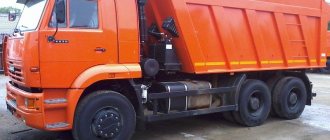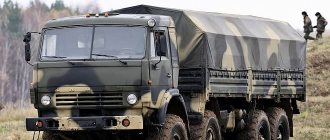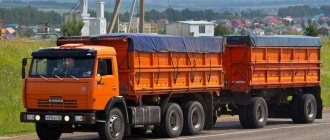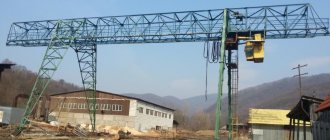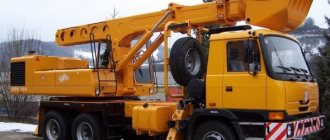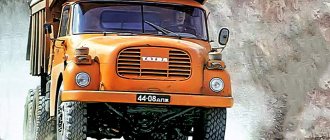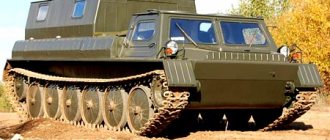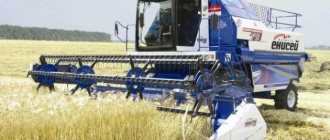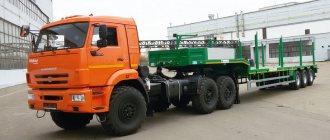The insulated van (thermal booth) KAMAZ-5325 with a 4x2 wheel arrangement is the latest line of KAMAZ vans of the EURO-5 environmental class with a new level of comfort for the driver. These thermal booths and refrigerators will be in demand among enterprises in the Krasnoyarsk Territory and Khakassia.
Description
5325 Kamaz is an onboard cargo tractor, produced from 1988 to the present. A popular truck model from the Kama plant. The main purpose of the machine is to work as part of a road train, possibly with a trailer. You can use GKB 8352 as the base model of the trailer. The main rule when operating a KamAZ with a trailer is the same size.
The prototype of Kamaz 5325 was the three-axle model Kamaz 53212. At the same time, version 5325 was developed more as a machine for increased axle load, for export to those countries where national standards and practical use allowed its use. Subsequently, model 5325 served as a prototype for the development of Kamaz 4325, an onboard tractor (as well as its modification, truck tractor 43253 and dump truck 43255). All vehicles from this model range are similar; they have similar technical characteristics with KamAZ models 5320 and 53212, tractor 5410, dump truck 551 and chassis 53213).
The characteristic features of the Kamaz 5325 are a metal body platform equipped with rear and side walls. The front side, unlike the others, is motionless and has a fairly large height. Frame of classic design, reinforced. Currently, the most common version of the Kamaz 5325 is in the form of a van.
Refrigerator – installation of refrigeration equipment on a van
Various refrigeration and heating units (HOU) can be installed on the KAMAZ 5325 van. They are divided into those that operate from the chassis engine and those that are driven by their own engine.
Each option has its own advantages and disadvantages, but in general, refrigerated trucks driven by a truck engine are more intended for intra-city distribution transportation, while refrigerated trucks driven by a truck engine are more suitable for transporting frozen products over long distances.
All proposed chemical dispensers can withstand the temperature set inside the van from 0°C to −20°C.
Vehicle specifications
Main technical characteristics:
- load capacity 12515 kg;
- total weight: 19000 kg;
- load in kg. on the drive axle - 11500;
- load in kg. (front axle) - 7500 kg;
- curb weight 6485 kg;
- load in kg. (on the drive axle) 2105;
- load at curb weight on the front axle - 4380 kg;
- fuel consumption 38 l. per 100 km;
- external turning radius - 7.5 m;
- maximum vehicle speed 90 km/h;
- batteries 2x12/210 V/Ah;
- voltage 24V;
- fuel tank capacity 350 l;
- fuel type: diesel;
- electro-pneumatic brakes, equipped with a directional stability system and a traction control system;
- type of brakes - disc;
- disc wheels, with rim size 9.00-22.5;
- tires tubeless, radial, 315/80 R22.5.
Onboard tractor-trailer with 4x2 wheel arrangement. The first copy rolled off the assembly line of the Kama Automobile Plant in 1988. The trucks were produced in small batches and were intended primarily for working with trailers. KamAZ 5315 is a basic model with a lifting capacity of 8.22 tons. KamAZ 5325 is an export version with an axle load of 13 tons, its load capacity is 11.06 tons. Modifications for tropical climates are available: KamAZ 531507, KamAZ 532507. The car body is a metal platform with opening side and rear sides, as well as a rigidly fixed high front side. The body design allows for the installation of an awning, the flooring is wooden. The three-seater cabin tilts forward, is equipped with noise and thermal insulation, seat belt attachment points, and a sprung driver's seat, which is adjustable in length and backrest angle. There are configurations with and without a berth. The cars are equipped with a V-shaped eight-cylinder turbocharged diesel engine KamAZ 74006.10 with a displacement of 10857 cm? and power 220 hp. at 2600 rpm. The car accelerates to a maximum speed of 100 km/h. For 100 km at a speed of 60 km/h, KamAZ 5315 consumes 23 liters. fuel, KamAZ 5325 - 24 l. fuel. The truck can also be equipped with a V-shaped eight-cylinder turbocharged diesel engine KamAZ 7403.10, or KamAZ 74037.10 (tropical version) with a displacement of 10857 cm? and power 260 hp. at 2600 rpm. The cars are equipped with a ten-speed gearbox; disc wheels; dependent front suspension on semi-elliptical leaf springs with shock absorbers and anti-roll bar; rear suspension - semi-elliptical leaf springs with rear sliding ends and additional springs, with shock absorbers and anti-roll bar. The trucks are equipped with a working brake system with drum mechanisms and a dual-circuit pneumatic drive.
Vehicle KamAZ 5315 and KamAZ 5325 4×2.2
Onboard tractor-trailers have been produced by the Kama Automobile Plant in small batches since 1988. They are intended primarily for working with trailers. KamAZ-5325 - export (axle load 13t). The body is a metal platform with opening side and rear sides, the front side is rigidly fixed and high. The flooring is wooden; installation of an awning is provided. The cabin is a forward-facing, three-seater cabin (a seat for a second passenger can be installed upon request), with noise and thermal insulation, equipped with seat belt fastening points, with or without a berth, depending on the configuration. The driver's seat is sprung and adjustable according to the driver's weight, length, and backrest angle.
Modifications: tropical version - KamAZ-531507 and KamAZ-532507.
Engine. Depending on the vehicle configuration, the following engine models are installed: KamAZ-74006.10 - power 162 kW (220 hp) at 2600 rpm, torque 667 Nm (68 kgf-m) at 1500-1800 rpm; KamAZ-7403.10 (with turbocharging) and KamAZ-74037.10 (with turbocharging, tropical version) - power 191 kW (260 hp) at 2600 rpm, torque 785 Nm (80 kgf-m) at 1500- 1800 rpm Fuel tank - 350 l (diesel fuel). Transmission. Depending on the configuration, the gearbox is a 5-speed (model 1 4) or 5-speed with a front splitter (model 15). Cardan transmission - two consecutive cardan shafts with an intermediate support. The drive axle is a Hungarian mod. A-111.49-3300 with a central main gear, planetary wheel gears, and a locked differential. Send number 6.67 or 6.27. Wheels and tires. Wheels - disc, rim 8.5V-20, wheel fastening with 10 studs. Tires for KamAZ-5315-11.00R20 (300R508), mod. I-111A, Air pressure in front tires 7.5; rear 6.7 kgf/cm. sq. The KamAZ-5325 tires are 12.00R20 (320R508). Number of wheels 6+1. Suspension. Dependent: front - on polyelliptic leaf springs with shock absorbers and anti-roll bar; rear - on semi-elliptical leaf springs with rear sliding ends and additional springs, with shock absorbers and anti-roll bar. Front axle - mod. A-832.0 1-3100. Brakes. The working system is with drum mechanisms and a double-circuit pneumatic drive. The parking brake is applied to the rear axle brakes from spring energy accumulators, the drive is pneumatic, and at the same time serves as a spare brake. The auxiliary brake is a motor retarder with a pneumatic drive. The brake drive is equipped with thermodynamic air drying. The trailer brake drive is two-wire.
Transmission, clutch KamAZ 5325
Kamaz 5325 is equipped with a hydraulic drive with hydraulic booster. Clutch type: single-disc, diaphragm. Clutch model MFZ 430.
Clutch mechanism mod MFZ - 430: 1 - drive shaft; 2 - flywheel; 3 — driven disk; 4 — pressure disk; 5 - thrust ring; 6 - diaphragm; 7 — clutch casing; 8 — clutch release; 9 — clutch release fork; 10 — clutch release fork shaft; 11 — restrictive ring; 12 — gearbox; 13 — pneumatic hydraulic booster.
Weight and overall dimensions
Today the KamAZ-5325 vehicle is characterized by the following parameters. How:
- length / height / width of the side version – 8.56 / 3.10 / 2.95 meters;
- chassis length - 6.63 meters;
- turning radius – 7.5 meters;
- load capacity – 12.5 tons;
- curb weight - 6.5 tons.
Reviews of KamAZ 5325
Novel:
“It’s a rare car, we have such a model in production for 16 euro pallets. Wheel formula 4x2. Class of 2022. Cummins engine, power 242 hp. Six-speed gearbox. It can be used for transportation with a range of up to 300 km.
Advantages: very high quality engine, sufficient power. The air intake system is located under the cab for more efficient additional loading of the front axle. This means there will be more load capacity for the rear axle.
Disadvantages: The van is very close to the cab.”
Isothermal van made of sandwich panels
The thermal box is made using frameless technology using vacuum gluing; the thermal van is intended primarily for the transportation of perishable and frozen food products.
The van's doors are located at the rear, double-leaf with rubber seals for tightness and a drainage visor. During production, imported galvanized rod-type fittings are used.
The total nominal load capacity of the van reaches 9.2 tons (10 tons), the internal volume of the superstructure is 38 m3, capacity is up to 16 euro pallets
Not extra strength
Saving fuel by 3-4% for a modern truck is already a great luxury, and the best engineering minds in the world are struggling with these indicators. But thanks to the lifting axle, it is possible to achieve a reduction in consumption of 5–7%, which, with rising prices for diesel fuel, becomes a significant indicator.
The engine power was not stifled for the sake of efficiency. In practice, the cargo carrier is concerned with high tempo and maintaining high tempo of traffic. Trucks do not drive on paper maps, but get stuck in transit traffic jams, and hills from the Carpathians to Transbaikalia are not uncommon on highways. On long climbs, acceleration on two-lane highways in ragged mode through a series of towns and villages, the fuel consumption of a more powerful engine will be even lower than that of the most economical one, since it does not need to be overclocked. In general, a road train weighing over 30 tons in traffic requires a torquey engine with a reserve of torque. You also need to make allowances for power loss in mountainous areas. Therefore, the 400-horsepower 6-cylinder 11.97-liter turbodiesel OM 457LA.V/3 with Euro 5 environmental standard became an acceptable compromise. It allows you to quickly start up to the permitted speed of 90 km/h. Confident acceleration and controlled movement are the key to safe driving.
Cabin interior
The interior of the original truck was ascetic, not providing much comfort for the driver. Only modifications with a high cabin were equipped with a berth. After restyling, the car began to be equipped with an Axor cabin, which was developed and created by the Mercedes-Benz brand.
This design solution has significantly increased the level of comfort, primarily due to air-suspension seats equipped with various adjustment mechanisms. The new cabin does not have a berth. However, its dashboard is more ergonomic and informative. In addition, it is equipped with a number of modern electronic systems, air conditioning and heating.
Oh, how many of you were there?
Lift axles have been used on commercial vehicles since the early 1950s to save fuel and preserve the chassis. The first Soviet truck with a lifting axle, Sisu, was released only in 1967, and then by order of the Finnish exporter Konela Oy. But even when the MAZ-516 went into production two years later, the idea never received proper distribution. The benefits of saving diesel fuel and reducing tire wear did not find understanding in the minds of Soviet car sloppiness, while these cars were in demand among the zealous Finns. In the early 1980s, Nummek Oy equipped the KAMAZ-5315 chassis with lifting axles, producing 6x4-2 and 6x2-2 versions of the two-axle truck. Using the resulting base, Hankkija Oy and Tehtaat Oy produced MKT milk tankers for Valio, and the Finn-Stroi Oy joint venture ordered multi-lift versions for swap bodies. But as we see, neither in the 1980s nor in the 1990s did domestic automakers or exporters use lifting axles on truck tractors!
Steering and instrument panel KAMAZ 65209-S5
The gear shift knob and handbrake, as well as other KamAZ 65209 controls are located at hand, you don’t need to reach for them. Instrument readings and indicators remain visible even when direct sunlight hits the dashboard. The latter is standard for all products of the manufacturer. Materials that are pleasant to the touch are used for its finishing.
Above the instrument panel there are a pair of buttons designed to control the lift axle. The first activates the manual bridge control mode, and the second – automatic. In this case, the on-board computer reacts to the vehicle’s load and, if necessary, lowers the additional axle.
Top for the Thrifty
The KAMAZ-65209 truck tractor in technical perfection closes the line of long-range vehicles, for which the new sub-brand NEO was invented too late at the plant. It’s a shame, but if GAZ has NEXT, then the “kamaxors” (KAMAZs with Mercedes-Benz Axor cabs) should have had a new designation from childhood. However, instead, KAMAZ played with German associations with a confusing set of numbers. So KAMAZ-65209 acquired the second designation T2640.
NEO does not belong to the line of classic budget transport solutions, which includes “Stayers”, military “Mustangs” and low-frame 6-ton “Kamazyats” of the 4308 family. But at the optimal price, they enter into intense competition with budget Eurotrucks, which were previously actively purchased by retail. The advantages of a lifting axle became all too obvious during the crisis. A reduction in operating costs for fuel by 2–3% (and this is the minimum!) will compensate for the increase in prices for diesel fuel. Increased mileage on non-drive rear axle tires will reduce long-term operating costs. Optimally, it is possible to work on roads with an axle load limit of 10 tons on roads with unstable load-bearing capacity, or in cases with weight restrictions (bridges and overpasses) in the regions. For example, according to the national project “Safe and High-Quality Highways” on federal highways in Russia, the number of frames of the automated weight and dimensional control system (ASVGK) will be increased from 27 to 387. And there is confidence that the limit on the middle axle of 10 tons for road trains with a total weight of 40 tons is motivated inspectors will be monitored specifically.
Stanovoy Ridge
The KAMAZ frame with an installation length of 7790 mm is rolled in Naberezhnye Chelny from imported rolled steel, the brackets and hitch are secured using high-strength bolts. The front part of the left side member is used to mount a bracket that combines the fastening of the front springs and the cab. Power steering is also installed on it. Integral brackets reduce weakening and twisting of the side members at this location. This improves handling and protects the frame from deformation.
A 500 liter fuel tank, providing a range of up to 1,500 km, is mounted on the right side of the frame, and a spare wheel holder is optionally mounted on the left side. As a standard, the spare tire will have to be kept on the saddle or semi-trailer. To comply with Euro 5 environmental standards, the car is equipped with a 70 liter AdBlue tank.
The average height of the chassis to the upper flange of the side member is 940 mm. It can be mounted with a fifth wheel from one of three companies (Orlandi, Jost or SAF-Holland) under a standard 2-inch coupling pin with a diameter of 50.8 mm.
The height of the SSU is designed to work with semi-trailers of the most popular standard with a nominal height of the support platform of 1150 mm. However, modernization for taller semi-trailers is not excluded.
